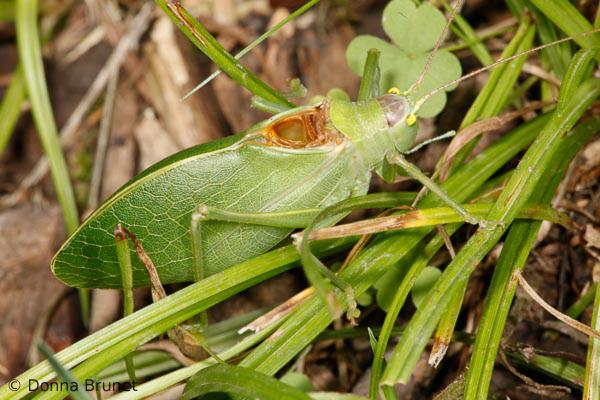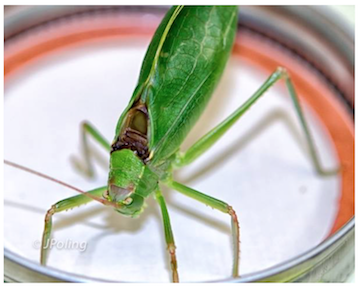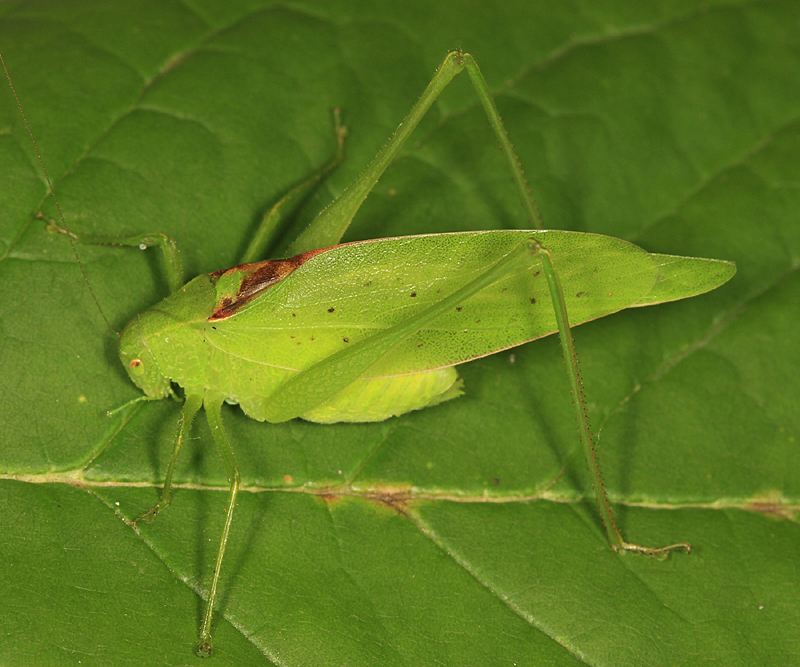The Insect Choruses of Late Summer


Dave Horn’s captured Common True Katydid looking truly unhappy about spending the night in a jar in the refrigerator. Photograph by Jim Poling of BRNN
by Linda Martinson BRNN August 2015
In July, Dr. David Horn, an Emeritus Professor from the Entomology Department of The Ohio State University, gave a moth identification presentation for the Blue Ridge Naturalist Network. While collecting moths for the presentation, there was a storm one night, and the next day Dave found a specimen of a Common True Katydid, so he took a detour during the moth ID class and explained why True Katydids are rarely seen but often heard.
The Common True Katydid is the star vocalist of the cacophonous insect chorus after dark in the forests from late summer into the fall. They are singing for female attention and a chance to mate before they are killed by a frost. Like many other singing insects, True Katydids produce sounds by stridulation, i.e., by rubbing one body part against another. To sing, they raise their front wings slightly and move them back and forth. The sharp edge of one wing (the scraper) rubs against the ridge (the file) of the other wing producing a chirp or trill that is amplified by the wing membranes.
True Katydids are not commonly seen because they live high in tree tops, especially oaks. They also camouflage well because they resemble a leaf. They have large forewings but cannot fly, although when they fall out of the trees, usually after a storm like the one Dave found,they do walk along the ground to find another tree to climb.
The male True Katydid of North America sings in quick bursts of two, three, or four notes with a crisp, harsh, and authoritative tone. They often form large synchronized choruses alternating their songs with a call-and-response rhythm between tree tops usually drowning out every other sound in the area. Before a male katydid begins to sing, he listens to his neighbors to choose a singing group to join. This results in a large, pulsating, and compelling synchronization of sound that can be frightening to people who haven’t heard it before. For example, the early Pilgrims wrote accounts about the terrifying insect sounds they heard at night in the late summer.
When the night temperatures begin to drop, the insects sing more and more slowly and their songs sound more creaky and “groaning” until they stop completely by October. So for the next six weeks or so, you can enjoy these strangely comforting night sounds of the insect choruses, and then they will end. But if you miss their songs in the winter, you can listen online or order an MP3 download or CD featuring ten relaxing lullabies of late summer and autumn insect choruses at songsofinsects.com an excellent and informative website created by Will Hershberger. Also check out their ideas for capturing singing insects and keeping them through the winter to listen their songs.

Common True Katydid about 2 – 2.5 inches long
(Pterophylla Camellifolia)
Photograph: Missouri Department of Conservation

The False Katydid (Amblycorypha Oblongifolia)
Photograph: PBase.com







43 comments